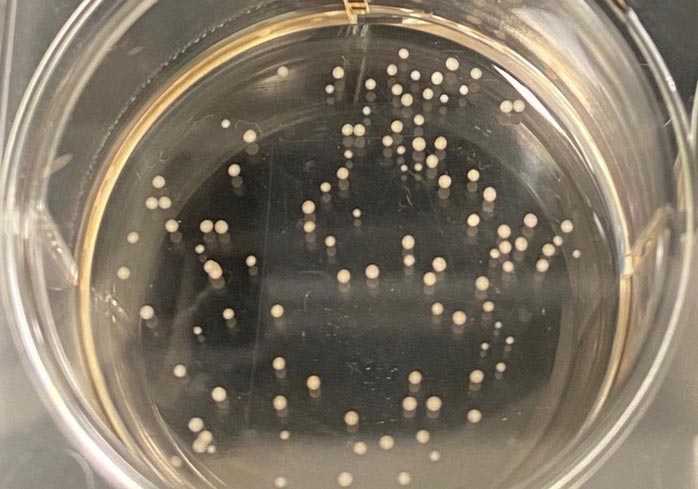Why we fit a mini brain with a mini cap

Brain organoid in petri dish
Credit: Carolina Romero, Center for Alternative to Animal Testing, Bloomberg School of Public Health
Engineering feat expands what researchers can accomplish with organoids.
It could be the world’s tiniest EEG electrode cap, created to measure activity in a brain model the size of a pen dot. Its designers expect the device to lead to better understanding of neural disorders and how potentially dangerous chemicals affect the brain.
This engineering feat, led by Johns Hopkins University researchers and detailed today in Science Advances, expands what researchers can accomplish with organoids, including mini brains—the lab-grown balls of human cells that mimic some of a brain’s structure and functionality.
“This provides an important tool to understand the development and workings of the human brain,” said David Gracias, a Johns Hopkins chemical and biomolecular engineer and one of the creators. “Creating micro-instrumentation for mini-organs is a challenge, but this invention is fundamental to new research.”
Since organoids were first created more than a decade ago, researchers have modified stem cells to create small-scale kidneys, lungs, livers, and brains. The complex, miniature models are used to study how the organs develop. Researchers study unaltered organoids next to ones that are genetically modified, injected with viruses, and exposed to chemicals. Organoids, particularly mini brains, are increasingly important in medical research because they can be used in experiments that would otherwise require human or animal testing.
But because the conventional apparatus to test organoids is flat, researchers have been able to examine only limited cells on their surface. Knowing what’s happening to a larger number of cells in the organoid would help understanding of how organs function and diseases progress, Gracias said.
“We want to get information from as many cells as possible in the brain, so we know the state of the cells, how they communicate and their spatiotemporal electrical patterns,” he said.
Humans “are not ‘Flat Stanley,’” said co-author Lena Smirnova, a research associate in the Department of Environmental Health and Engineering at the Bloomberg School. “Flat measurements have inherent limitations.”
Inspired by the electrode-dotted skull caps used to detect brain tumors, the team created tiny EEG caps for brain organoids from self-folding polymer leaflets with conductive polymer-coated metal electrodes. The microcaps wrap around the entirety of an organoid’s spherical shape, enabling 3D recording from the entire surface, so that, among other things, researchers can listen to the spontaneous electrical communication of neurons during drug tests.
The data is expected to be superior to the current readings from conventional electrodes on a flat plate.
“If you record from a flat plane, you only get recordings from the bottom of a 3D organoid sphere. However, the organoid is not just a homogeneous sphere,” said first author Qi Huang, a PhD Candidate in Chemical & Biomolecular Engineering. “There are neuron cells that communicate with each other that’s why we need a spatial-temporal mapping of it.”
With more detailed information from organoids, researchers can study whether chemicals used in consumer products cause problems in brain development, said co-author Thomas Hartung, director of the Center for Alternatives to Animal Testing at Johns Hopkins Bloomberg School of Public Health.
“Some chemicals like pesticides are especially suspicious as many kill insects by damaging their nervous system,” Hartung said. “Flame retardants are another class of chemicals where we have concerns.”
Researchers hope that readings from the caps could reduce the number of animals needed to test chemical effects. Traditional testing of just one chemical requires about 1,000 rats and costs about $1 million, Hartung said. The results from organoids are also more germane, he added, because human brains are very different from rat and mice brains.
Co-authors of the study include Bohao Tang, July Carolina Romero, Yuqian Yang, Gayatri Pahapale, Tien-Jung Lee, Itzy E. Morales Pantoja, Cynthia Berlinicke, Terry Xiang, Mallory Solazzo, and Brian S. Caffo from Johns Hopkins University, Saifeldeen Khalil Elsayed and Zhao Qin from Syracuse University, and Fang Han from the University of Washington.
The work is supported by U.S. Environmental Protection Agency Star grant R8395050, Johns Hopkins University Discovery Award, National Institutes of Health/ National Institute of Biomedical Imaging and Bioengineering P41EB031771, R01EB029977 and National Institute on Drug Abuse U54DA049110.
Journal: Science Advances
DOI: 10.1126/sciadv.abq5031
Media Contact
Laura Cech
Johns Hopkins University
lauracech@jhu.edu
All latest news from the category: Life Sciences and Chemistry
Articles and reports from the Life Sciences and chemistry area deal with applied and basic research into modern biology, chemistry and human medicine.
Valuable information can be found on a range of life sciences fields including bacteriology, biochemistry, bionics, bioinformatics, biophysics, biotechnology, genetics, geobotany, human biology, marine biology, microbiology, molecular biology, cellular biology, zoology, bioinorganic chemistry, microchemistry and environmental chemistry.
Newest articles

Pinpointing hydrogen isotopes in titanium hydride nanofilms
Although it is the smallest and lightest atom, hydrogen can have a big impact by infiltrating other materials and affecting their properties, such as superconductivity and metal-insulator-transitions. Now, researchers from…

A new way of entangling light and sound
For a wide variety of emerging quantum technologies, such as secure quantum communications and quantum computing, quantum entanglement is a prerequisite. Scientists at the Max-Planck-Institute for the Science of Light…

Telescope for NASA’s Roman Mission complete, delivered to Goddard
NASA’s Nancy Grace Roman Space Telescope is one giant step closer to unlocking the mysteries of the universe. The mission has now received its final major delivery: the Optical Telescope…



